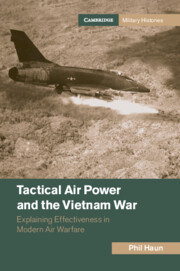Book contents
- Tactical Air Power and the Vietnam War
- Cambridge Military Histories
- Tactical Air Power and the Vietnam War
- Copyright page
- Dedication
- Contents
- Figures
- Maps
- Tables
- Preface
- Abbreviations
- 1 Introduction
- 2 Tactical Air Power Theory
- 3 Vietnam and Rolling Thunder: 1965–1966
- 4 Khe Sanh and Tet: 1967–1968
- 5 Commando Hunt I–III and Cambodia: 1969–1970
- 6 Commando Hunt V–VII and Lam Son 719: 1971–1972
- 7 Easter Offensive and Linebacker I & II: 1972–1973
- 8 Analysis and Conclusion
- 9 Epilogue
- Book part
- Index
7 - Easter Offensive and Linebacker I & II: 1972–1973
Published online by Cambridge University Press: 04 January 2024
- Tactical Air Power and the Vietnam War
- Cambridge Military Histories
- Tactical Air Power and the Vietnam War
- Copyright page
- Dedication
- Contents
- Figures
- Maps
- Tables
- Preface
- Abbreviations
- 1 Introduction
- 2 Tactical Air Power Theory
- 3 Vietnam and Rolling Thunder: 1965–1966
- 4 Khe Sanh and Tet: 1967–1968
- 5 Commando Hunt I–III and Cambodia: 1969–1970
- 6 Commando Hunt V–VII and Lam Son 719: 1971–1972
- 7 Easter Offensive and Linebacker I & II: 1972–1973
- 8 Analysis and Conclusion
- 9 Epilogue
- Book part
- Index
Summary
Chapter 7 examines the Easter Offensive and the Linebacker I & II air campaigns. When the NVA launched the offensive, the question remained whether the ARVN could incorporate air–ground coordination lessons from Lam Son 719. The ARVN held on two of three fronts but faltered along the demilitarized zone (DMZ). Effective US air power and resolute ARVN forces, coordinated by US military advisors and air liaison officers, held off further NVA advances as the ARVN regrouped to launch a counteroffensive to retake Quang Tri. In May, the United States launched Linebacker I to interdict enemy lines of communication, which failed to weaken the NVA as it fought through the summer. Instead, in September the ARVN and US air forces combined arms offensive retook Quang Tri. The decisive defeat of the NVA convinced Hanoi to accept a peace treaty. However, South Vietnamese President Nguyen Thieu, excluded from the secret talks, balked at any deal that allowed NVA troops to remain in the country. After the November 1972 election, President Nixon ordered Linebacker II, the bombing of Hanoi, which compelled the North Vietnamese to return to Paris, but only to sign an agreement they had accepted in October following their defeat in the Easter Offensive.
Keywords
- Type
- Chapter
- Information
- Tactical Air Power and the Vietnam WarExplaining Effectiveness in Modern Air Warfare, pp. 163 - 201Publisher: Cambridge University PressPrint publication year: 2024



